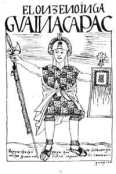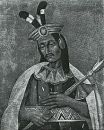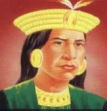Hello! This is part twenty of a multi-part series on the Inca Empire and the Conquistadors. If you want some background, the introduction to this series is right here, and part nineteen is here. Or, I mean, just go ahead and be confused. Your call!
At the same time Pizarro fell to an assassin’s blade, Cristobal Vaca de Castro stepped onto the shores of Panama. Vaca de Castro had arrived from Spain, where he had come from as an envoy of the king. When the king had heard of the death of Almagro, he ordered Vaca de Castro to Peru to investigate the situation. Vaca de Castro was also authorized by the king to take over the governance of Peru if something should happen to Pizarro.
As soon as he arrived, Vaca de Castro heard the bleak news. Pizarro was dead, and his assassin Diego Almagro II had declared himself governor, raising his followers in armed rebellion. Arriving in a Peru that was suddenly being split by its second civil war within two years, Vaca de Castro acted quickly. Uniting with a furious and grief-stricken Gonzalo Pizarro, who had been campaigning far to the north in modern-day Ecuador, Vaca de Castro raised an army against Diego Almagro II.
Diego Almagro II and his conspirators had attempted to seize control of Lima, but they found less support there than they had expected, and they were forced to flee the city. Raising his followers on the way, Almagro II and his men retreated to the city of Cuzco. Meanwhile, the royalist and Pizarro forces, led by Vaca de Castro and Gonzalo Pizarro descended upon the city. In 1542 at the Battle of Chupas, the royalist forces routed Almagro II’s men. Almagro II’s army was shattered, and he and his closest supporters were immediately executed. (MacQuarrie loc. 5639)

Of the twenty men who had killed Pizarro, fifteen were killed in the immediate aftermath of the assassination or executed after the Battle of Chupas. However, five of them still lived. Led by Diego Mendez, these men were able to escape execution after the battle, but they were the most wanted criminals in all of New Castille. With the Gonzalo Pizarro and Vaca de Castro’s men hot on their heels, Diego Mendez realized there was only one place in the New World where they could escape Spanish justice – Vilcabamba.
Diego Mendez and the last surviving assassins reached the Inca kingdom of Vilcabamba in 1542. Manco Inca’s spies had told the leader-in-exile all about the recent civil wars, and Manco Inca must have felt at least a little satisfaction when he heard his old enemy Pizarro was dead. He kept his face impassive, though, as Mendez and his men pleaded for their lives. Manco Inca’s generals advised him to execute the Spaniards quickly and be done with it. Manco Inca, however, had a different idea.
Manco Inca allowed the Spaniards to stay in Vilcabamba, although they were not allowed within the city and were instead quartered in the nearby outpost of Vitcos. They would be allowed to live and stay under Manco Inca’s protection, although there would be a price. In exchange for letting them live safely in Vilcabamba, the fugitive Almagristas would train Manco Inca’s men in the arts of European warfare – how to fire arquebuses, how to load them properly and most importantly, how to ride captured Spanish horses.
Over the next two years the Spaniards lived in Vilcabamba, training Manco Inca’s men and teaching Manco Inca about life and politics in Spanish Europe. For their part, the Spaniards were protected by Manco Inca’s forces and fed and treated well. When they weren’t training the Inca warriors, the Spaniards whiled away the hours playing quoits, a game that Manco Inca often joined and became quite good at. (MacQuarrie loc. 5671)
It’s not hard to imagine what Manco Inca had in mind when he spared the Spaniards. If he was able to modernize his men’s weapons and training, his army would potentially be able to finally meet the Spanish army in the open field. In Vilcabamba, the thick jungles dissuaded and complicated attacks, but previous raids by the Spanish had shown that a determined force could still shatter any army Manco could put forward. With cavalry and firearms, though, the Incas could turn from a thorn in the side of the Spaniards into a serious threat.
Unfortunately for Manco Inca, that was not to be. Two years later, in 1544, his guests saw an opportunity to return to Spanish society. A new man had come from Spain to rule the newly named Viceroyalty of Peru, and this viceroy had no connections to the Pizarros. Diego Mendez thought this new man offered the best chance of a pardon the assassins were ever going to get. He and his men began quiet plans to return to Lima and throw themselves on the mercy of the new viceroy.
This plan had an obvious flaw, though. Even if the new viceroy felt no loyalty to the Pizarros, the fact was that Mendez and his fellow assassins had murdered the lawful governor of New Castille. Any reasonable law-abiding ruler would immediately execute the men, regardless of their sympathies. Mendez and his men knew that they would never be pardoned. Unless, of course, they were able to bring the new viceroy a substantial gift. A gift such as the head of the man who had raised all of the Inca Empire against the Spaniards, killed more Spaniards than any other Inca and who still ruled a kingdom of guerrilla fighters in the heart of an impenetrable jungle: their host, Manco Inca.
One day in 1544 Manco Inca rode down to Vitcos to visit the Spaniards, unarmed and accompanied by only his fourteen-year-old son Titu Cusi. The Spaniards were already playing a game of quoits, and they cheerfully invited Manco Inca to join them. Manco Inca joined them, and for a time the day proceeded as any other, just a group of men playing a game to idly pass the time. Then, Manco Inca pulled back his arm to make a throw, and Diego Mendez slowly slid behind him.
As Manco Inca began his throw Mendez drew out a short knife from his sleeve and coolly slammed the knife into the Inca emperor’s back. Manco Inca stumbled forward in shock, then turned, raising his arms to strike at Mendez. The other Spaniards surged forward, drawing their own hidden knives, and fell on Manco Inca. As his son Titu Cusi watched in horror, the assassins of Pizarro drove their knives into Manco Inca again and again. Manco Inca fought back as fiercely as he could, but eventually his strength gave out and he collapsed.

Mendez and the assassins raced towards their horses and galloped off into the distance, leaving the Inca emperor bleeding out on the ground. The Spaniards hoped to escape to the safety of Lima, but they were caught by Inca soldiers the next day and brutally executed.
In the end, Pizarro and Manco Inca fought for the Inca Empire, but neither was able to rule the empire for long. The two men who had battled for years over the empire fell to the blades of the same men.
Dates
c. 1200 Kingdom of Cuzco is founded
1438-1471 Reign of Pachachuti
1471-1493 Reign of Tupac Inca
1492 Columbus discovers the Americas
1493-1527 Reign of Huayna Capac
1526 Pizarro and his thirteen men discover the Inca city of Tumbez
1527 Huayna Capac dies of smallpox brought by the Europeans
1527-1531 Civil war between Atahualpa Inca and Huascar
1531 Pizarro’s conquering expedition to Peru, Pizarro captures Atahualpa Inca, Atahualpa executes his brother Huascar
1533 Pizarro executes Atahualpa Inca and installs Manco Inca as the new Inca
1535 Pizarro founds the city of Lima
1536 Manco Inca rebels against the Spanish, leads a massive uprising that traps them in Cuzco and Lima. Juan Pizarro is killed in the battle
1537 Diego Almagro seizes Cuzco from the Pizarros. Manco Inca retreats from the capital to Vilcabamba
1538 Hernando Pizarro defeats and executes Almagro
1540 Hernando Pizarro is sentenced to twenty years imprisonment in Spain for killing Almagro.
1541 Pizarro is assassinated by supporters of Almagro
1544 Manco Inca is assassinated by Pizarro’s assassins
Characters
Incas

Huayna Capac – Emperor of the Incas [Died of plague in 1527]

Huascar – Son of Huayna Capac and the heir to the throne [Executed by Atahualpa in 1531]

Atahualpa – Brother of Huascar and rival for the throne, emperor of the Incas [Executed by Pizarro in 1533]

Manco Inca – Younger brother of Atahualpa and Huascar, emperor of the Incas [Executed by Pizarro’s killers in 1544]
The Pizarros

Francisco Pizarro – Oldest of the brothers and mastermind of the expedition. A talented leader of men and a good strategist [Assassinated by Diego Almagro II’s men in 1541]
Hernando Pizarro – Second of the brothers; a canny and calculating tactician [Sentenced to twenty years in prison in Spain in 1540]
Gonzalo Pizarro – Third brother; charming womanizer with a vicious cruel streak
Juan Pizarro – Youngest of the brothers and a powerful, impetuous soldier [Killed during the Siege of Cuzco by Manco Inca’s forces in 1536]
Almagristas

Diego Almagro – Partner with Pizarro and one of his oldest friends, a hardened veteran of many battles ready to strike it rich [Executed by Hernando Pizarro in 1538]
Diego Almagro II – Almagro’s son, a hot-headed young soldier [Defeated by Gonzalo Pizarro and Cristobal Vaca de Castro’s forces and executed in 1542]
Royalists
 Cristobal Vaca de Castro – Viceroy of Peru, a flexible and adaptable man
Cristobal Vaca de Castro – Viceroy of Peru, a flexible and adaptable man
 Blasco Nunez Vela – Viceroy of Peru, grating and brusque administrator
Blasco Nunez Vela – Viceroy of Peru, grating and brusque administrator
 Pedro de la Gasca – Viceroy of Peru, a clever politician and adept manipulator
Pedro de la Gasca – Viceroy of Peru, a clever politician and adept manipulator
One thought on “Chapter 20: The Death of Kings Part II”